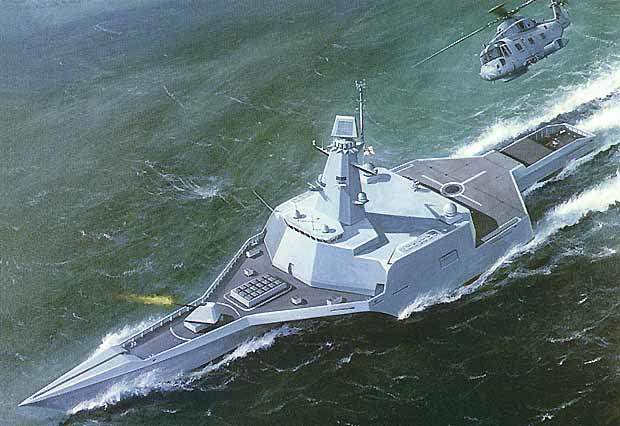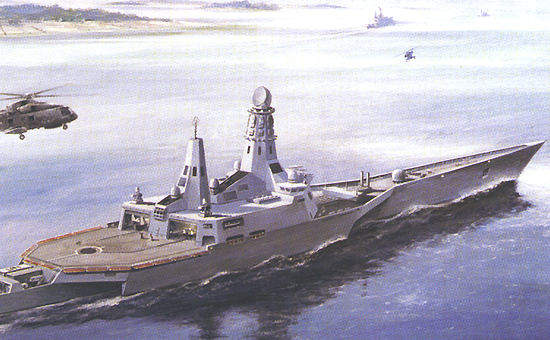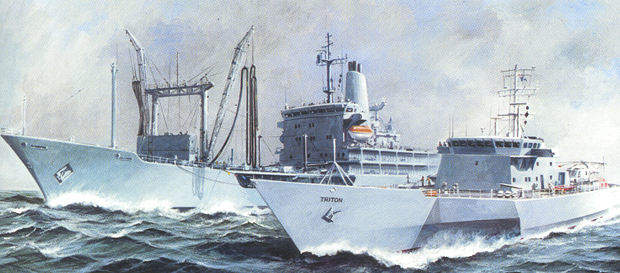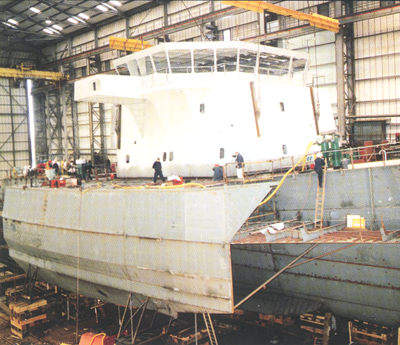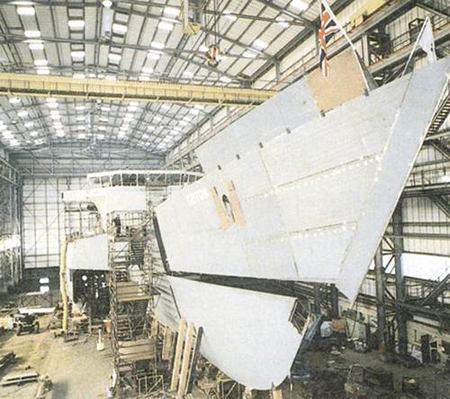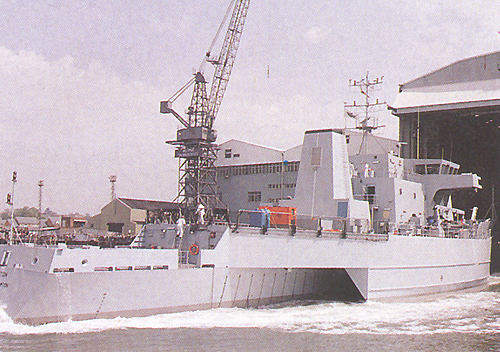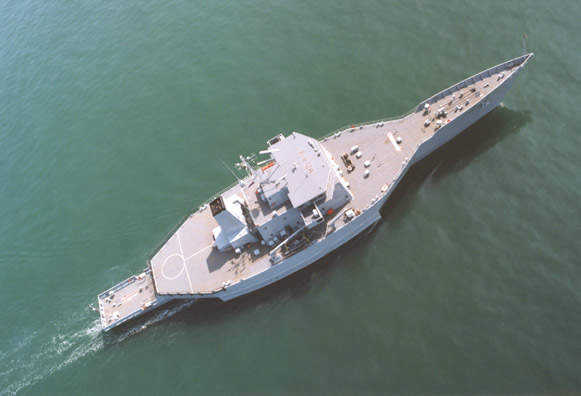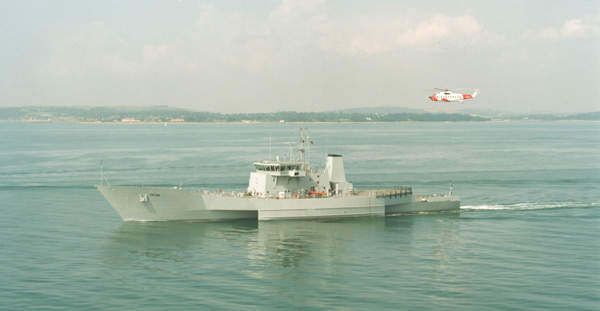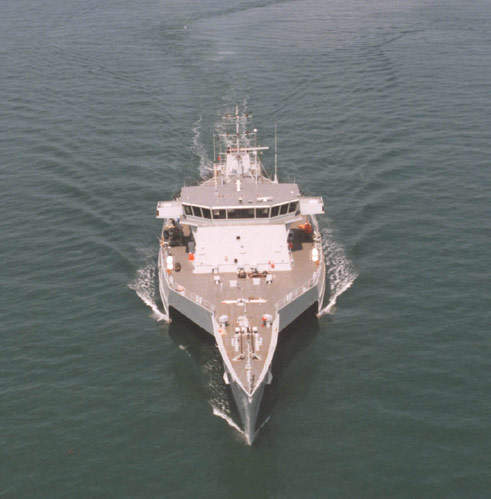The Triton trimaran research ship was a technology demonstrator ship for the Royal Navy’s future surface combatant (FSC) frigate requirement, due to enter service from 2013 and replace the Type 23 frigates. Triton is the world’s largest motor powered trimaran (triple-hulled) vessel, with a length of 90m and beam of 22m. QinetiQ (formerly DERA, the Defence Evaluation and Research Agency) funded the design and manufacture of the vessel, to be used to quantify the structural and seakeeping performance of the trimaran.
In August 1998, the UK Ministry of Defence (MoD) awarded a contract to Vosper Thornycroft to construct the Trimaran, called RV (research vessel) Triton. The vessel was launched in May 2000 and delivered in August 2000. Triton then began a two-year risk reduction trials programme for the UK MoD and the US Department of Defense.
Following completion of the trials programme, Triton has been used as a trials platform for other QinetiQ technologies including the composite propeller.
In January 2005, Triton was sold to Gardline Marine Sciences, a UK company based in Great Yarmouth, Norfolk. Triton was used for hydrographic survey work for the civil hydrography programme (CHP) on behalf of the Maritime and Coastguard Agency (MCA). The vessel was fitted with a sensor suite which includes the Kongsberg Simrad EM1002 multibeam echo-sounder, a GPS attitude / heading system, surface navigation and ultra-short baseline sub-surface acoustic tracking system, Gardline Voyager5 integrated survey system and Caris post-processing system.
Triton was the launch vessel for the QinetiQ 1 programme to break the world altitude record for a manned balloon. The target altitude of 25 miles (132,000ft) would take the two pilots into the stratosphere.
The giant helium-filled balloon had a nine-acre area and was as high as the Empire State Building. An attempt on the record, in September 2003, was aborted after an 8m tear appeared in the helium balloon envelope during launch.
Triton has become a patrol vessel since it was chartered to the Australian Customs Service in December 2006. It has been deployed in northern waters of Australia to work along with other customs and Royal Australian Navy patrol boats.
The vessel has been modified to provide additional accommodation and also fitted with two 0.50-calibre machine guns to perform patrol operations. The vessel is also equipped with two 7.3m high-speed rigid hull inflatable boats (RHIBs). The boats are powered by Evinrude outboard motors and have the range of 200nm at 30kt speed. Following the modifications in the UK and Singapore shipyards, it was delivered to the customs in January 2007.
Trimaran hullform trials programme
The trials programme to determine the suitability of the trimaran hullform began in October 2000 and included operations in a variety of sea states and at differing speeds. Triton successfully completed replenishment at sea (RAS), structural loading and seakeeping trials, landing and take-off trials by a Royal Navy Lynx mk8 helicopter, towing operations and small boat launch and recovery. It also took part in trials with the US Coastguard. The trials were concluded in September 2002, successfully proving that the design could operate in exactly the same way as an equivalent mono-hull vessel.
Advantages of trimaran design
The advantages of a trimaran hullform over conventional mono-hulls are thought to be: reduced costs, reduced signature, significantly less drag increased speed, increased length, giving greater stability, and more room for the upper deck, which could be used for the flight deck as well as hangars for helicopters and extra armaments.
Applications
The Trimaran development has been driven by frigate type applications. Concept studies have been carried out for other roles including offshore patrol, concept studies for future vessel development – for example, the mini landing platform helicopter ship (mini LPH), fast roll-on / roll-off rapid deployment support ships, and air-capable stealth vessels.
Demonstrator vessel contruction
The demonstrator is built at two thirds the size of a full-scale warship and although not armed it is capable of carrying containerised Naval military systems at sea. The 90m length of the Trimaran demonstrator meets the structural constraints of the ship’s plating and longitudinal stiffening. The main hulls and bridge deck are of steel construction.
A comprehensive ballast system accommodates trials in various operating conditions. The structure will accept containerised trials equipment. The flight deck strength is to be rated to accommodate a Lynx helicopter and be capable of operating unmanned aerial vehicles.
Provision is made for future electric propulsion trials involving the installation of exchange permanent magnetic main motors, a battery/fuel cell compartment, and flight deck and engine room sites for at-sea tests of future gas turbine alternators. The demonstrator will accommodate integrated technology masts.
The engines exhaust between the hulls as a method of reducing the thermal signature of the ship. Low noise and radar signatures are achieved using commercially available materials and services.
Navigation and communications
The Triton navigation suite included Northrop Grumman Sperry Marine Bridgemaster E S-band and X-band flat screen radars with ARPA (Automatic Radar Plotting Aids), two Northrop Grumman (Litton) LMX400 GPS receivers, Furuno Loran-C receiver, Northrop Grumman electronic chart system and Skipper GDS 101 echo sounder.
Satellite communications systems include Northrop Grumman (Litton) INMARSAT SAT-C and INMARSAT SAT-M and Nera INMARSAT SAT-B.
Trials instrumentation system
The demonstrator had two laboratories. One laboratory housed the Trials Instrumentation System (TIS) which collected data including wind speed and direction, temperature, wave height and ship’s motion, with the other for general trials purposes. The TIS system can record over 400 channels of data at sampling rates of either 20Hz, 200Hz or 2,000Hz. All the data is time-stamped from a GPS sourced time synchronisation signal. TIS sensors include: Miros WAVEX wave height radar, TSK wave height radar, Trimble AGPS system, AGI windspeed and environmental monitoring system.
Propulsion
The propulsion system consists of two Paxman 12VP185 2MW diesel generators and two 350kW electric side thrusters with a single central screw. QinetiQ has replaced the fixed pitch propeller with a new composite propeller. The five-bladed composite propeller has a diameter of 2.9m. The use of the lighter composite allows for thicker blades which reduces vibration and consequently acoustic signature. Dowty Propellers manufactured the blades and Wärtsilä Propulsion the nickel aluminium bronze hub.
Accommodation
Accommodation for 14 civilian crew and up to 30 customs boarding party officers is provided in 48 berths. The other onboard features include a first aid centre, health screening and quarantine isolation area and secure holding areas.

